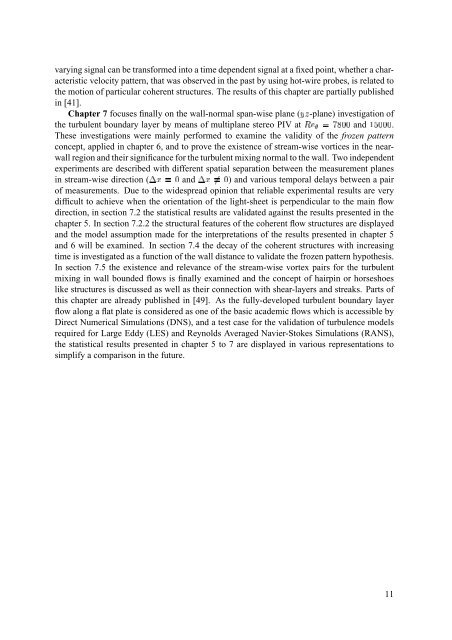The significance of coherent flow structures for the turbulent mixing ...
The significance of coherent flow structures for the turbulent mixing ...
The significance of coherent flow structures for the turbulent mixing ...
Create successful ePaper yourself
Turn your PDF publications into a flip-book with our unique Google optimized e-Paper software.
varying signal can be trans<strong>for</strong>med into a time dependent signal at a fixed point, whe<strong>the</strong>r a characteristic<br />
velocity pattern, that was observed in <strong>the</strong> past by using hot-wire probes, is related to<br />
<strong>the</strong> motion <strong>of</strong> particular <strong>coherent</strong> <strong>structures</strong>. <strong>The</strong> results <strong>of</strong> this chapter are partially published<br />
in [41].<br />
Chapter 7 focuses finally on <strong>the</strong> wall-normal span-wise plane ([-plane) investigation <strong>of</strong><br />
<strong>the</strong> <strong>turbulent</strong> boundary layer by means <strong>of</strong> multiplane stereo PIV and*1¥¥¥.<br />
<strong>The</strong>se investigations were mainly per<strong>for</strong>med to examine <strong>the</strong> validity <strong>of</strong> <strong>the</strong> frozen pattern<br />
concept, applied in chapter 6, and to prove <strong>the</strong> existence <strong>of</strong> stream-wise vortices in <strong>the</strong> nearwall<br />
region and <strong>the</strong>ir <strong>significance</strong> <strong>for</strong> <strong>the</strong> <strong>turbulent</strong> <strong>mixing</strong> normal to <strong>the</strong> wall. Two independent<br />
experiments are described with different spatial separation between <strong>the</strong> measurement planes<br />
in stream-wise direction (<br />
at&%<br />
£g¥) and<br />
£<br />
and various temporal delays between a pair<br />
54¥.¥<br />
<strong>of</strong> measurements. Due to <strong>the</strong> widespread opinion that reliable experimental results are very<br />
difficult to achieve when <strong>the</strong> orientation <strong>of</strong> <strong>the</strong> light-sheet is perpendicular to <strong>the</strong> main <strong>flow</strong><br />
direction, in section 7.2 <strong>the</strong> statistical results are validated against <strong>the</strong> results presented in <strong>the</strong><br />
chapter 5. In section 7.2.2 <strong>the</strong> structural features <strong>of</strong> <strong>the</strong> <strong>coherent</strong> <strong>flow</strong> <strong>structures</strong> are displayed<br />
and <strong>the</strong> model assumption made <strong>for</strong> <strong>the</strong> interpretations <strong>of</strong> <strong>the</strong> results presented in chapter<br />
¢¡f£g¥ h¡©<br />
5<br />
and 6 will be examined. In section 7.4 <strong>the</strong> decay <strong>of</strong> <strong>the</strong> <strong>coherent</strong> <strong>structures</strong> with increasing<br />
time is investigated as a function <strong>of</strong> <strong>the</strong> wall distance to validate <strong>the</strong> frozen pattern hypo<strong>the</strong>sis.<br />
In section 7.5 <strong>the</strong> existence and relevance <strong>of</strong> <strong>the</strong> stream-wise vortex pairs <strong>for</strong> <strong>the</strong> <strong>turbulent</strong><br />
<strong>mixing</strong> in wall bounded <strong>flow</strong>s is finally examined and <strong>the</strong> concept <strong>of</strong> hairpin or horseshoes<br />
like <strong>structures</strong> is discussed as well as <strong>the</strong>ir connection with shear-layers and streaks. Parts <strong>of</strong><br />
this chapter are already published in [49]. As <strong>the</strong> fully-developed <strong>turbulent</strong> boundary layer<br />
<strong>flow</strong> along a flat plate is considered as one <strong>of</strong> <strong>the</strong> basic academic <strong>flow</strong>s which is accessible by<br />
Direct Numerical Simulations (DNS), and a test case <strong>for</strong> <strong>the</strong> validation <strong>of</strong> turbulence models<br />
required <strong>for</strong> Large Eddy (LES) and Reynolds Averaged Navier-Stokes Simulations (RANS),<br />
<strong>the</strong> statistical results presented in chapter 5 to 7 are displayed in various representations to<br />
simplify a comparison in <strong>the</strong> future.<br />
11
















